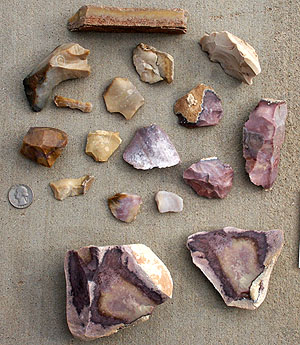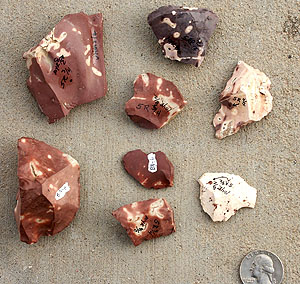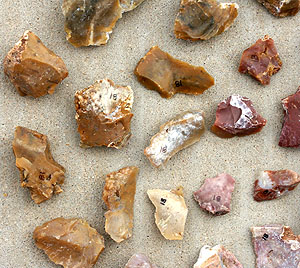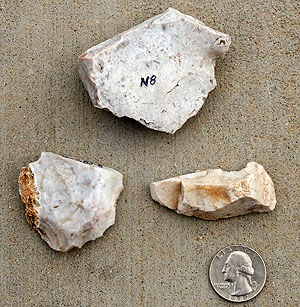Van Horn Quarries
The area around Van Horn in southwestern Culberson County contains enormous quantities of varied lithic materials—cherts, agates, and felsites. The presence of numerous quarry sites attests to the fact that prehistoric peoples made heavy use of the area. Jack Hedrick and other members of the El Paso Archeological Society documented and collected source samples from nine quarries in the vicinity of Van Horn. They named several of the quarries by the distinctive material found within. The documented sites include the Purple-Tan Chert quarry (41CU449), Spotted quarry (41CU389), Butterscotch quarry (41CU424), three white chert quarries (41CU349, CU372, and CU379), and three felsite quarries (41HZ397, CU441, and CU443).
The Purple-Tan chert quarry is located on the ridges and slopes of a range of Cretaceous limestone hills east of Van Horn. The chert, exposed in nodules, is extremely dense, and has a fine, glossy texture. It produces an excellent conchoidal fracture and thin, translucent flakes. Overall, the color purple is a minor constituent of this material, usually on the outer rind which is ordinarily removed during flintknapping, as a result, the most common color is tan. Other hues include grayish orange, very pale orange, grayish red-purple, pale red, and pinkish gray.
Spotted quarry is located on a mesa in the Van Horn Mountains south of Van Horn. It consists of broken nodules of chert that have eroded out of the limestone cap of the mesa. The stone has a medium to fine grained matte texture and excellent conchoidal fracture. It is characterized by its spotted combinations of moderate red to grayish red and very pale orange.
The documented butterscotch quarry is located in the Wylie Mountains southeast of Van Horn. This quarry’s distinctive agate resembles butterscotch taffy and ranges in color from light brown and dark yellowish brown to moderate brown. There are numerous other locations for a very similar stone, such as a locale at Needle Peak in the vicinity of Pinto Canyon in Chinati/Vieja Mountains.
The white chert quarries are on ridges and slopes of three separate Cretaceous limestone hills east of Van Horn. The stone is coarse to fine grained and has good conchoidal fracture. Its color ranges between white, medium light gray, and pinkish gray.
The pebbles and boulders of the felsite quarries are scattered among pediment gravels in the Carrizo Mountains west of Van Horn. Their coarse to fine grained material is extremely hard and dense and comes in dark reddish brown, dark red, moderate red, and grayish red. Fragments and nodules of agate, chalcedony, and jasper are also abundant in the gravels and boulders of the pediments between the Carrizo and Van Horn Mountains.
Resources from these quarries were used extensively throughout prehistoric times and appear in virtually all forms of chipped-stone artifacts. They are found throughout the southern Culberson County area and far beyond. Felsite was generally used for heavier and larger tools, the finer cherts and exotics (agate, jasper, and chalcedony) were used for projectile points and smaller tools.
Hedrick, John A.
1989 A Preliminary Report on Archeological Resources in Southern Culberson County in the Vicinity of Van Horn, Texas. Bulletin of the Texas Archeological Society 59:129-156.



